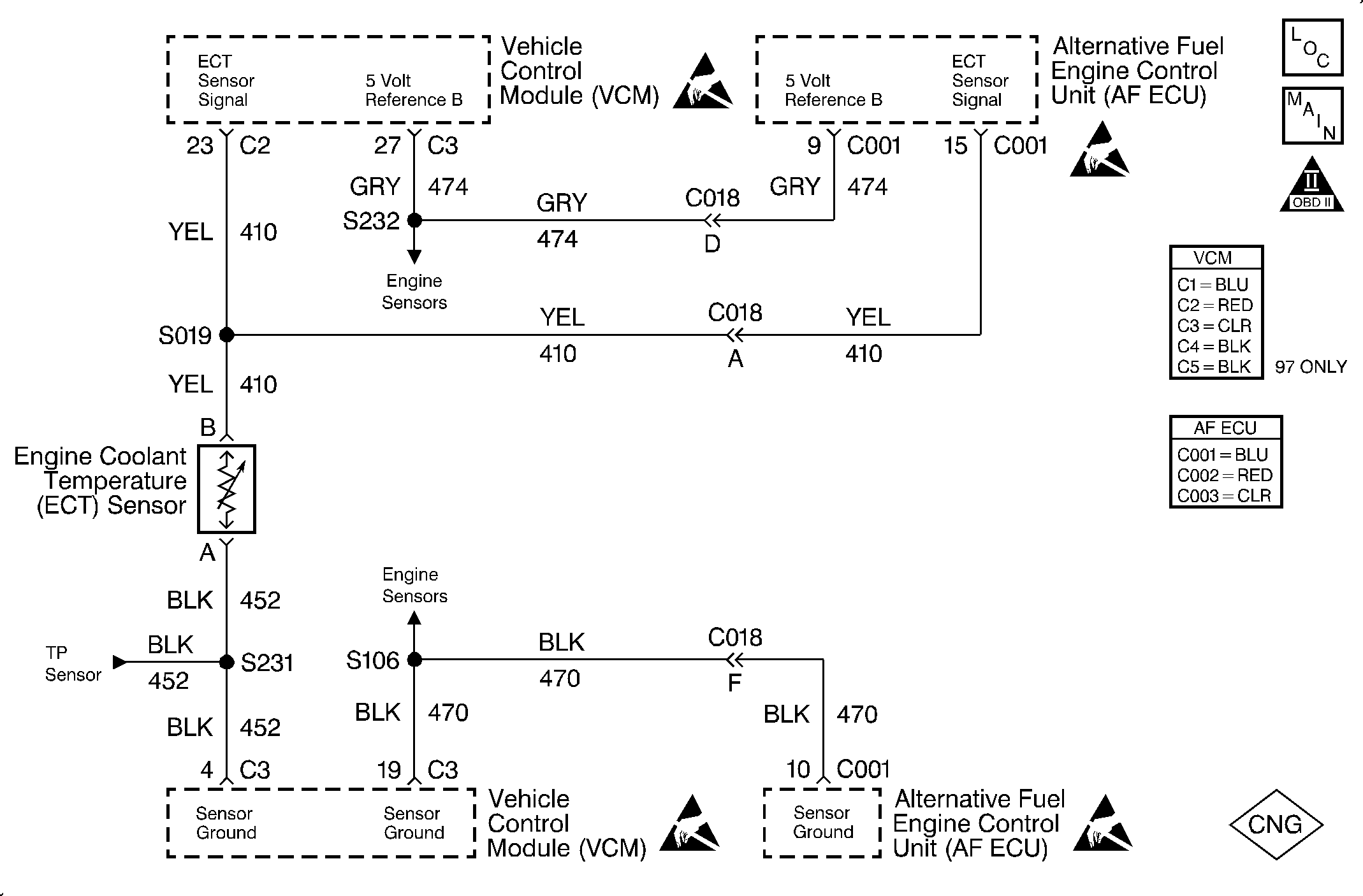
Circuit Description
The ECU monitors the ECT sensor while the engine is warming in order to determine how long the engine takes to achieve a specified coolant temperature increase required for a Closed Loop operation.
A DTC sets if the ECU determines that the engine does not achieve a predetermined engine temperature increase in a specified amount of time. This DTC will not run if either the intake air or the engine coolant temperature measures below a specific temperature. The ECU will only run this DTC on a cold start and only once per cold start.
This is a type A DTC.
Conditions for Setting the DTC
The following conditions will set the DTC:
| • | The vehicle is in the CNG operation mode. |
| • | The engine run time is greater than 500 seconds. |
| • | None of the following DTCs are active: 14, 15, 23, 25. |
| • | The intake air temperature is greater than -15°C (5°F). |
| • | The vehicle speed is greater than 5 mph. |
| • | The mass air flow is greater than 8.5 g/sec. |
| • | The ECT at start is less than 33°C (91°F). |
| • | The ECT is greater than -17°C (1°F). |
Action Taken When the DTC Sets
The ECU will set DTC 16 and illuminate the MIL lamp after 1 fault has occurred.
Conditions for Clearing the MIL/DTC
The ECU turns the MIL OFF after 3 consecutive driving trips without a fault condition present. A DTC will clear if no fault conditions have been detected for 40 warm-up cycles (coolant temperature has risen 40°C (72°F) from the start-up coolant temperature and the engine coolant temperature exceeds 70°C (160°F) during that same ignition cycle) or the code clearing procedure has been used.
Diagnostic Aids
Always diagnose ANY VCM codes that are present before beginning this diagnostic procedure.
A skewed ECT sensor or an engine thermostat that does not operate correctly will set a DTC 16.
A poor connection, rubbed-through wire insulation or a broken wire inside the insulation may cause an intermittent.
Check for the following conditions:
| • | A poor connection or a damaged harness. Inspect the ECU harness connector for the following conditions: |
| - | Backed out terminals |
| - | Improper mating |
| - | Broken locks |
| - | Improperly formed or damaged terminals |
| - | Poor terminal to wire connection |
| - | Damaged harness. |
| • | The intermittent test. Monitor a DVOM connected to the ECU terminal while moving the related connectors and the wiring harness if the connections and the harness are OK. The voltage reading changes if the failure is induced. This may help isolate the location of the malfunction. |
Test Description
The number(s) below refer to the step number(s) on the diagnostic table.
-
This test checks the engine warm-up rate.
-
This test checks the coolant sensor reading and the actual coolant temperature.
Step | Action | Value(s) | Yes | No |
|---|---|---|---|---|
1 | Was the Alternative Fuels (AF) Powertrain On-Board Diagnostic (OBD) System Check performed? | -- | Go to Step 2 | Go to Alternative Fuels (AF) Powertrain On Board (OBD) System Check |
2 |
Is the resistance below the specified value? | 0.4 ohms | Go to Step 4 | Go to Step 3 |
3 |
Has the problem been corrected? | -- | Go to Step 10 | -- |
4 | Reconnect all the connectors. Is the action complete? | -- | Go to Step 5 | -- |
5 |
Are the values close? | -- | Go to Step 6 | Go to DTC P0117 ECT Sensor Circuit Low Voltage in Engine Controls - 5.0, 5.7L in the C/K Truck Service Manual |
Does the ECT value increase steadily greater than the specified value over the starting ECT value within 9 minutes? | 25°C (45°F) | Go to Diagnostic Aids | Go to Step 7 | |
7 |
Was a problem found? | -- | Go to Engine Cooling System in the C/K Truck Service Manual | Go to Step 8 |
Are the values close? | -- | Go to Engine Cooling System in the C/K Truck Service Manual | Go to Step 9 | |
9 | Replace the ECT sensor. Refer to ECT Sensor Replacement in Engine Controls - 5.0, 5.7L in the C/K Truck Service Manual. Is the action complete? | -- | Go to Step 10 | -- |
10 |
Does the diagnostic run and pass? | -- | Go to Step 11 | Go to Step 2 |
11 | Are any ECU or VCM DTCs displayed that have not been diagnosed? | -- | Go to the applicable DTC table | System OK |
